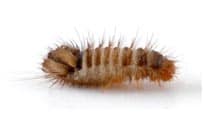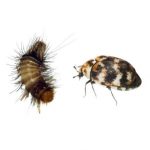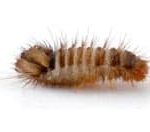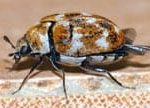Votre panier est actuellement vide !

The carpet beetle
The length of the adults can vary from 2 to 4 mm.It has a rather oval shape.The color can vary: it can be brown or black, with spots and yellow or white scales on the back.The belly is covered with fine gray-yellow scales.At rest, the antennae fold into cavities of the thorax.The eyes are a little rounded.The legs are short and retract under the belly.The back wings are hard and meet in the middle of the back.The larvae are hard and have a very long tail. The eyes are a little rounded.the legs are short and retract under the belly.the back wings of the beetle are hard and meet in the middle of the back.the larvae are brown and are quite easy to recognize, they have three tufts of golden hairs at the end of the abdomen.they measure from 4 to 5 mm.
Latin Name: Dermestidae
Description:Adult length can vary from 2 to 4 mm.It has a rather oval shapeColor can vary: it can be brown or black,with yellow or white spots and scales on the back.The belly is covered with fine gray-yellow scales.At rest, the antennae fold into cavities in the thorax.The eyes are a bit rounded.The legs are short and retract under the belly. The back wings of the beetle are hard and meet in the middle of the back.The larvae are brown and are quite easy to recognize, they have three tufts of golden hairs at the end of the abdomen.They measure 4 to 5 mm.
Reproduction:The female beetle can lay 30 to 100 eggs, which will hatch between 10 to 18 days later.The larval stage can last up to a year and the adults live one or two months.
Habits:In homes, beetle larvae attack carpets, woolen fabrics,they can feed on woolen clothing and other products from animals.They can be found in flower beds and often enter the home with cut flowers.
Prevention:Beetle infestations can often be prevented by a series of simple actions:installing screens, putting screens over ventilation hatches,plugging holes in the foundation,cleaning clothes before storing them,vacuuming where there is a lot of dust and under carpets as well.Treatments can be applied but should be administered by specialists to make sure all sources of infestation are treated.


